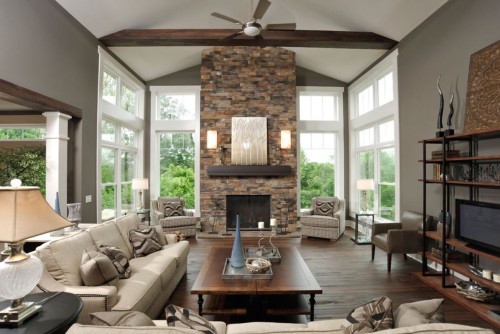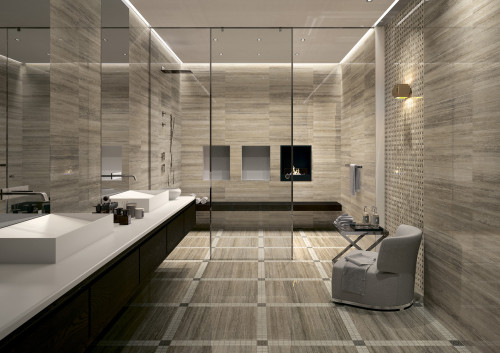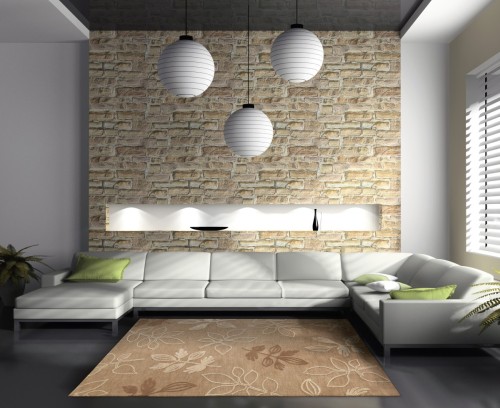Stone is one of the favorite materials in the decoration of interiors and exterior of houses, apartments, household territories. It is respected for creating a special atmosphere carrying medieval beauty, naturalness, relevance of design.
Content
Natural stone is very suitable for decorating open space, but for the interior decoration of the premises, this material is quite bulky. To facilitate and simplify the process of creating a "stone" style in its apartment or house, in the building materials market there is a large selection of decorative tiles for stone for interior decoration.
Types of decorative tile under stone
- Decorative tile can imitate different types of natural stone: limestone, marble, slate and others, and each pebble may differ in size and shape.
- The stone on the tile may have a cut view with a small terrain and roughness of the surface, while the individual elements are about the same size.
- Often, the decorative tile mimics the brickwork, which can be very non-standard in color, form and surface treatment.
- Numerous online stores selling decorative tile under stone have whole collections of eloquent photos that help customers decide on the choice.
- To give different properties with concrete material, a combination of special additives is used: sand, crumples, pumice, petty gravel, reinforcing additives, hardening accelerators and plasticizers.
Concrete tiles
The most common material for creating an artificial stone is concrete. Externally, the tile of concrete will not differ from the natural stone, besides, it has a number of more winning properties compared to natural material:
- low cost and easy laying;
- ease of material;
- keeps heat, increases sound insulation.
The concrete analog of natural stone is also poorly amenable to fire and allows you to create a stylish design of the premises.
Plaster tiles
- Another affordable material for the manufacture of decorative tiles on the stone wall is gypsum. This material is not very resistant to endure the weather whims, so it is intended only for lining of dry premises. It is not necessary to apply it in bathrooms, shower, saunas, near fireplaces, stoves and rude without thermal insulation due to increased humidity and temperature.
- Plaster decorative tiles for stone is made of environmentally friendly material and provides high levels of heat and sound insulation. You can clean the gypsum tile from dust and dirt both with a vacuum cleaner and special wet wipes or conventional rags. It is worth avoiding the use of hard scratching devices for cleaning and chemical detergents.
- Gypsum tile is preferably covered with varnish, in which case its wear resistance increases.
Outdoor stone tile
- The floor tile is more often made of natural stone, since here the weight of the material is no longer as important as for the walls. The stone floor looks pathos and will last for a long time without flaws.
- The granite tile is often found in public places and even in the conditions of crowded people do not lose their source data for a long time. In residential buildings, it will be appropriate in the bathroom, in the kitchen, in the toilet, because it is completely not afraid of water.
- In addition, the granite tile has many different shades: gray, pink, green, bluish, red. The floor may be optional one color: combining the tile of different shades, you can create unique ornaments and make the floor very bright and solemn.
- The marble tile is inferior to the strength of the granite tile. Nevertheless, it has a more porous surface and is successfully used in the bathroom, making it the floor beautiful and not slippery. This material also allows combining colors and create unique outdoor drawings.
- Shale tile is rich in natural natural shades. It can be a combination of gray, white and rich green divorces. The floors, decorated with such a tile, do not absorb moisture and durable, so also suitable for the bathroom, shower, toilet and kitchen.
Ceramic tile
- Porcelain tiles are made from rock rocks and spam with the addition of high-quality clay. This mixture is not inferior in its qualities to natural granite thanks to special technology.
- The tile is created in conditions that are very reminiscent of the natural process of the birth of stone. The firing point of 1300 ° C makes it unusually strong and resistant to the influence of moisture. On such a tile, it is almost impossible to put scratch.
- The most accessible type of porcelain tile does not pass the polishing stage. It practically does not wear out over time and does not lose its appearance.
- The glazed tile is most often used for facing floors in the house, as it has a decorative layer that is not suitable for common areas. This type of tile has the largest selection of ornaments and colors that guarantee the beautiful appearance of the decorated surface.
Decorative tile under the stone with their own hands
- Tile under stone can be made with your own hands from plaster or cement. At the same time, it will be no worse than from the building materials store, and much cheaper. There are special silicone forms on sale, with which the tile is made.
- First, in the 3: 1 ratio, cement and sand is mixed to a homogeneous mass, which is then bred by water, bringing to the consistency of sour cream. Dyes add to the mixture.
- Then the resulting mass is poured into the form of up to half and with the help of shaking is tamped for 1 minute. A metal mesh is placed on top of the solution for greater tile strength and cover another layer of solution. In the second layer of concrete, the dye to add no need.
- After 12 hours, the stone mass is removed from the form and leave to dry for 2 weeks. The empty form should be washed using the Fairy detergent.
- Plate from plaster is made in the same way as concrete. But there is one feature: the gypsum quickly solidifies, so the solution should only be mounted for one portion. To slow the process of solidification of the gypsum, citric acid add to it. Gypsum solution freezes for several tens of minutes.
Features of the design of walls under the stone
- It should be remembered that the decoration of the room with decorative tile under the stone can significantly darken the room. Therefore, the correct solution will be the alternation of stone zones with sections of walls covered with light wallpaper or paint. We will not be accommodated by additional lighting devices.
- Perfectly looks on the background of a stone green curly plants, aquariums, fountains - everything related to wildlife.
- The decorative tile under natural stone around the fireplace, door openings and windows looks winning, and the tile under the brick fits perfectly into the modern interior of the room.
- The tile under the stone is well combined with any other materials: wallpaper, paint, wood. To impart brilliance, you can cover the surface of the lacquer stone, which will make the room even more elegant. At the same time, bright and bright shades are welcomed, which will remove the feeling of lack of light.
- If the room is narrow, it is better to abandon the use of design under the stone, otherwise it will greately even more decrease in size. Decorative structures from large stones will also look good only in sufficiently spacious premises.
Preparation of the surface of the wall
- Walls that will be waved with decorative tiles must be maximally aligned. To keep the tile well, the base should be very durable and reliable.
- Before laying the tile, it is necessary to carry out shuttering of the walls. If the walls are trimmed with plasterboard, the tile facing is possible only if the thickness mall thickness of the plasterboard is at least 12.5 mm. It is necessary that the sheets are reliably strengthened at least 3 transverse lines.
- For laying decorative tiles, special tile or silicone glue or liquid nails are used. The glue is sold in a dry form and divorced with water according to the instructions to a homogeneous mass.
- If the tile has to be attached to the plasterboard, then it is necessary to find out whether glue is suitable for such a case, having studied the instructions.
- Also, the surface of the walls is carefully processed by a special primer.
Laying tiles
- Before laying the tile, you need to decide exactly where and how it will be applied. To do this, it is necessary to sketch, having thought out the size of the stones and the laying of the tile, after which the corresponding marks on the wall are made. The tile can be laid and decor the seam between the individual tiles.
- The process of laying the decorative tile under stone can be studied using numerous videos posted on the Internet.
- A solution of glue is applied on the wall with a spatula or cell. The amount of applied solution must correspond to the width of one row of tiles. If the tile is glued to the jack, it is enough to attach it to the applied solution and slightly move around the axis, after which it is noted to lean the tile to the bottom row, tapping onto its surface with a rubber hammer for more reliable fixation.
- To make a seam, use strips of plasterboard or plastic crosses that are removed after solidification of the solution.
- The rows of tiles under the stone is better to make it possible to make a noticeable stones displacement relative to each other, like brickwork. This option looks beautiful and natural. For each row it is desirable to pick up the elements of approximately equal width to avoid not very pleasant to the eye of the feeling of chaoticness.
- If you need to attach part of the tile, then it is possible to cut it with a grinder or a special tile cutting machine.
- When choosing a tile with a thickness of more than 1.5 cm, it is better to take pauses after laying 3 or 4 rows to froze the solution, otherwise there is a risk of deformation attached to the array wall.
- At least 2 days is given to the complete pouring of the solution, after which you can remove the auxiliary profiles and strips for the formation of seams. The seams are sacroshed from the excess the fastening solution, and then the grout is performed. You can apply silicone grout between the tile using a special pistol and dispenser. The same manipulation can be done with the help of a conventional sponge or a finger, wrapped with a cloth.
Applying tiles under stone in different rooms
The decorative tile under the stone in the interior of the rooms can successfully beat different styles: Country, High-tech, historical mood. Options may be mass, from small fragments on the wall or around a specific design element to whole walls, from the floor to the ceiling laid down under the stone.
By stone, the corridors, the wall at the stairs, making the emphasis at the same time on additional lighting, for example, in the form of street lamps.
Stone tile in the kitchen
- The use of decorative tiles when designing a stone for a kitchen is a very good idea. Such space looks creative, richly, besides very practical in cleaning.
- Given the practicality of the use of such a tile, it is often used to decorate the "Fountains" zone in the kitchen. This place is most susceptible to temperature difference and complex pollution that are not terrible with artificial or natural stone.
- In addition to the design of the walls "Stone" theme, you can continue in the appearance of tabletops and other seats of the kitchen. Designs made of artificial stone can be a support of a table or other kitchen furniture. Thanks to new technologies for processing stone, which reduced the cost of finished products, granite, malachite and other stone countertops are no longer uncommon.
- Under the stone in the kitchen decorated plinths, window sills, eaves, various courses and bar racks.
Stone tile in the living room
In the living room, the use of decorative tiles on the stone wall should be quite thoughtful. It is impossible to overdo it here, because in this room there should be enough warmth and comfort.
However, the creation of an accent wall as a background for TV, paintings, watches, shelves and other accessories, can become a very bright idea of \u200b\u200bthe room design. Stone is used as a beautiful framing of arched passes, windows, fireplace zones, mirrors, doorways.
Stone tile in the bedroom
In this room, the design with the use of decorative tile under the stone is allowed in a very limited quantity, because the room should carry calm, warm, remind of rest. It is enough to restrict ourselves to small mosaic scenery from stone on the wall or decorate the mirrors, windows, doorways.
The use of tiles for stone will help create a unique and interesting design of your apartment, and it will be available at the price and does not take a lot of strength in the installation process. Boldly embody your ideas into reality and enjoy the cold and embossed beauty of the stone and other natural materials around you.






















